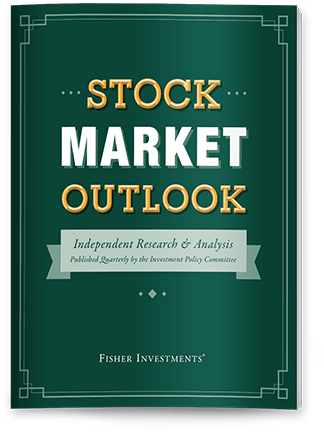Personal Wealth Management / Market Analysis
The Market Filters News and Noise on Fed ‘Independence’
Stocks are looking further out, as usual.
Editors’ Note: MarketMinder prefers no party nor any politician. We assess developments for their economic and market implications only.
Is this news or noise? This conundrum confronts investors daily, especially on the political front—no matter who or which party occupies the White House. Often, confusingly, the answer can be “both,” requiring investors to learn to see things differently from the crowd. So it is with Wednesday’s seeming seesaw over whether President Trump will dismiss Fed head Jerome Powell—and the broader issue of Fed independence. Heated headlines topped mastheads Wednesday and into Thursday morning, but markets barely blinked, which we think is right. What gives? Let us dive in.
At this point, it is no secret Trump is displeased with Powell, whom he appointed to succeed Janet Yellen in 2017. The administration routinely voices its desire for interest rate cuts, but Powell’s Fed has opted to hold after late 2024’s half-percentage-point cut. Early in his second term, Trump reportedly explored the possibility of firing Powell. That never progressed past whispers and stray comments, but Trump has also indicated Powell won’t get a second term, and his administration is apparently already vetting candidates to take the reins next year. As names surface, headlines parse their views and records to assess the likelihood they will be independent. But now and then, rumors of Powell’s early dismissal return. They did so Wednesday, with reports that Trump asked Congress if he can fire Powell—followed by Trump publicly calling termination “highly unlikely.” Coverage of this alluded to seesawing stock markets, falling and rising as the news evolved. But it all netted out to a slight, 0.3% S&P 500 rise on the day.[i]
We aren’t legal experts, but it is pretty clear the president can’t fire the Fed chair without “cause,” which policy disagreements about rate cuts don’t amount to. The Supreme Court specifically noted in May, as a tangent to a case about the presidential dismissal of agency heads, that the ruling to uphold those firings wasn’t a precedent to fire the Fed head without cause, owing to the agency’s unique quasi-private structure. Some who favor dismissing Powell argue a valid “cause” could be the renovation of the Fed’s headquarters going over budget. We will leave it to others to debate the merits of this and simply note that any attempt to do so would surely go to the Supreme Court, a lengthy and expensive process that seems a bit needless to undertake when Powell’s term ends in less than a year. This, too, stocks know.
So this is all news. The Fed conducts monetary policy, which can affect the economy—one of stocks’ main drivers. But it is also noise, with abundant he said, she said, speculation, exaggeration and fast-moving rumors.
The key: Think about all of this as markets do. Stocks move most on how reality unfolds relative to expectations in the next 3 – 30 months. We have always known there was a possibility of a new Fed head in this window, given term length is fixed. Trump’s gripes with Powell are well known, dating back to his first term. The names of the runners and riders to succeed him are also well known. The only thing that seems somewhat uncertain is whether the new Fed head will arrive sooner than the calendar says. But even this probably isn’t a huge deal for monetary policy or the economy’s trajectory over the entire 3 – 30 month window.
The other “noise” here is the chatter about “independence.” Headlines act as if this is a sacrosanct virtue that will be eradicated if a president fires a Fed chair. But America isn’t Turkey, where presidential meddling with the central bank results in severely misguided monetary policy at times. America’s Fed votes by committee, with the Fed head one voice and vote among 12. The other Fed board members and a rotating cast of regional Fed bank presidents also get a say. The Fed head can set the agenda and certainly has influence, but they don’t dictate what happens.
Congress is another check. The Fed’s dual mandate to target low unemployment and low inflation, enshrined by Congress in 1978, was a legislative response to politically influenced monetary policy. The Nixon administration famously cajoled Arthur Burns into going along with ill-guided low rates as part of the early 1970s’ wage and price controls. Theoretically, the dual mandate adds accountability on this front.
But also, the Fed isn’t as independent as many headlines want to tell you. It is inherently political. All central bankers are, for the simple reason that politicians appoint and reappoint them (and confirm those appointments). Upholding the notion of “independence” is also an inherently political act. Powell looks like a case in point here. When we look at tame inflation and slowing economic indicators here and there, the case for rate cuts looks fairly strong. The US yield curve is flat, while yield curves in Europe and Japan are pretty steep. A rate cut would steepen the US yield curve, likely helping lending and giving small businesses in particular some extra juice. But the more Trump argues publicly for rate cuts, the more incentive Powell has to wait and appear independent. We aren’t taking sides here or weighing in on anyone’s personality or arguments. Nor are we forecasting Fed rate moves, which is impossible. But it is clear trying to look apolitical risks resulting in political decisions. It is a weird irony, one markets get even if people can’t quite consciously fathom it.
How do we know they get it? Even with these repeat kerfuffles, even with all the harsh rhetoric and hyperbolic headlines, volatility has been rather muted this summer, and the S&P 500 continues clocking new highs. We don’t think this means stocks like (or dislike) a particular administration or Fed leadership. It just means they seem to be busy doing their day job: Chiefly, weighing corporate earnings 3 – 30 months out, and seeing these earnings don’t depend on the particulars of who is in the Fed or when and how they get there.
Lower volatility also tells us something key: As happened in Trump’s first term, markets appear to be getting more used to this administration’s style and rhetoric. Whether it is tariff threats, Fed head rumbles or what have you, the whispers and pronouncements seem to be holding less sway over sentiment, with smaller daily market moves as a result. We haven’t seen the sharp whipsaws in both directions we got in April. Rather, tiny wiggles are increasingly the norm, another sign markets are looking further out. To us, this is normal and healthy. Stocks aren’t missing anything—just adapting, moving forward and pricing in the future.
[i] Source: FactSet, as of 7/17/2025.
If you would like to contact the editors responsible for this article, please message MarketMinder directly.
*The content contained in this article represents only the opinions and viewpoints of the Fisher Investments editorial staff.
Get a weekly roundup of our market insights
Sign up for our weekly e-mail newsletter.

You Imagine Your Future. We Help You Get There.
Are you ready to start your journey to a better financial future?

Where Might the Market Go Next?
Confidently tackle the market’s ups and downs with independent research and analysis that tells you where we think stocks are headed—and why.





